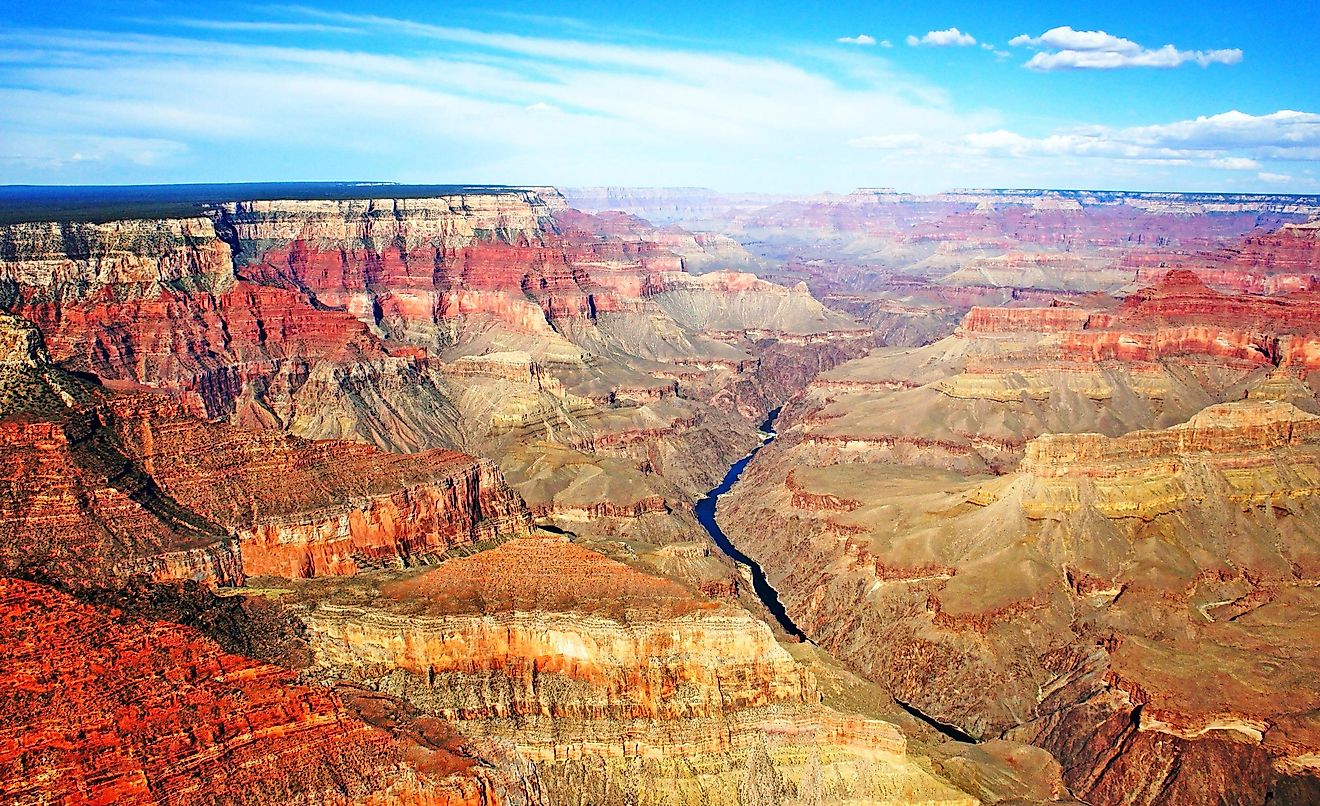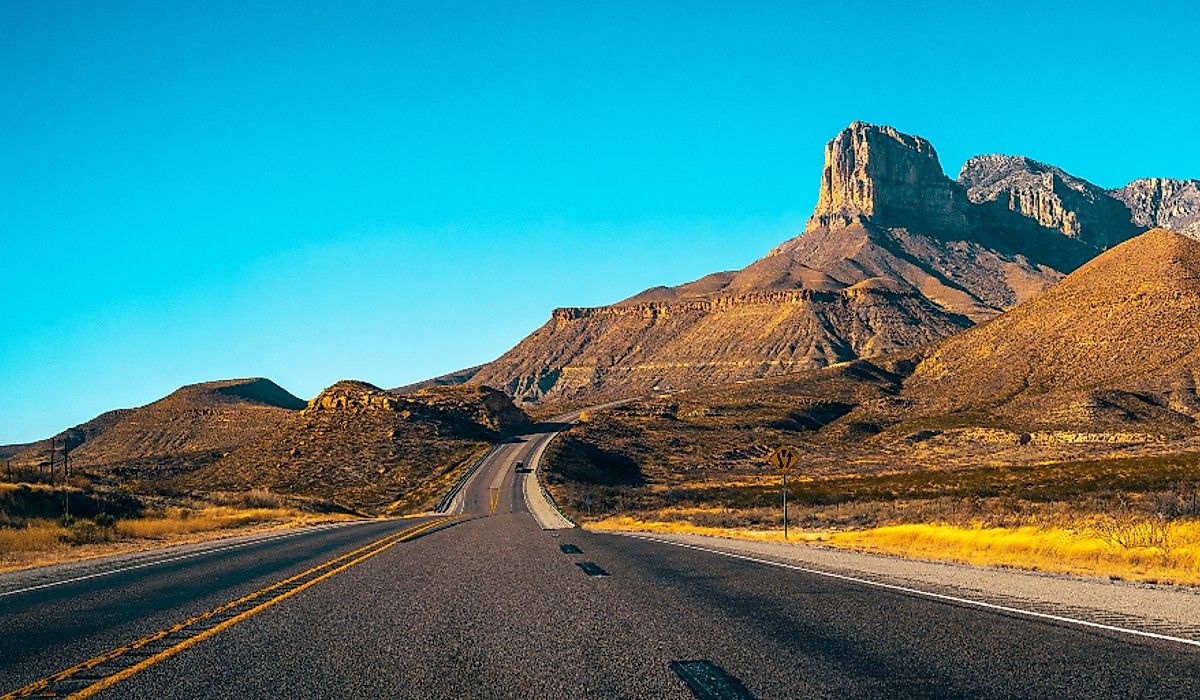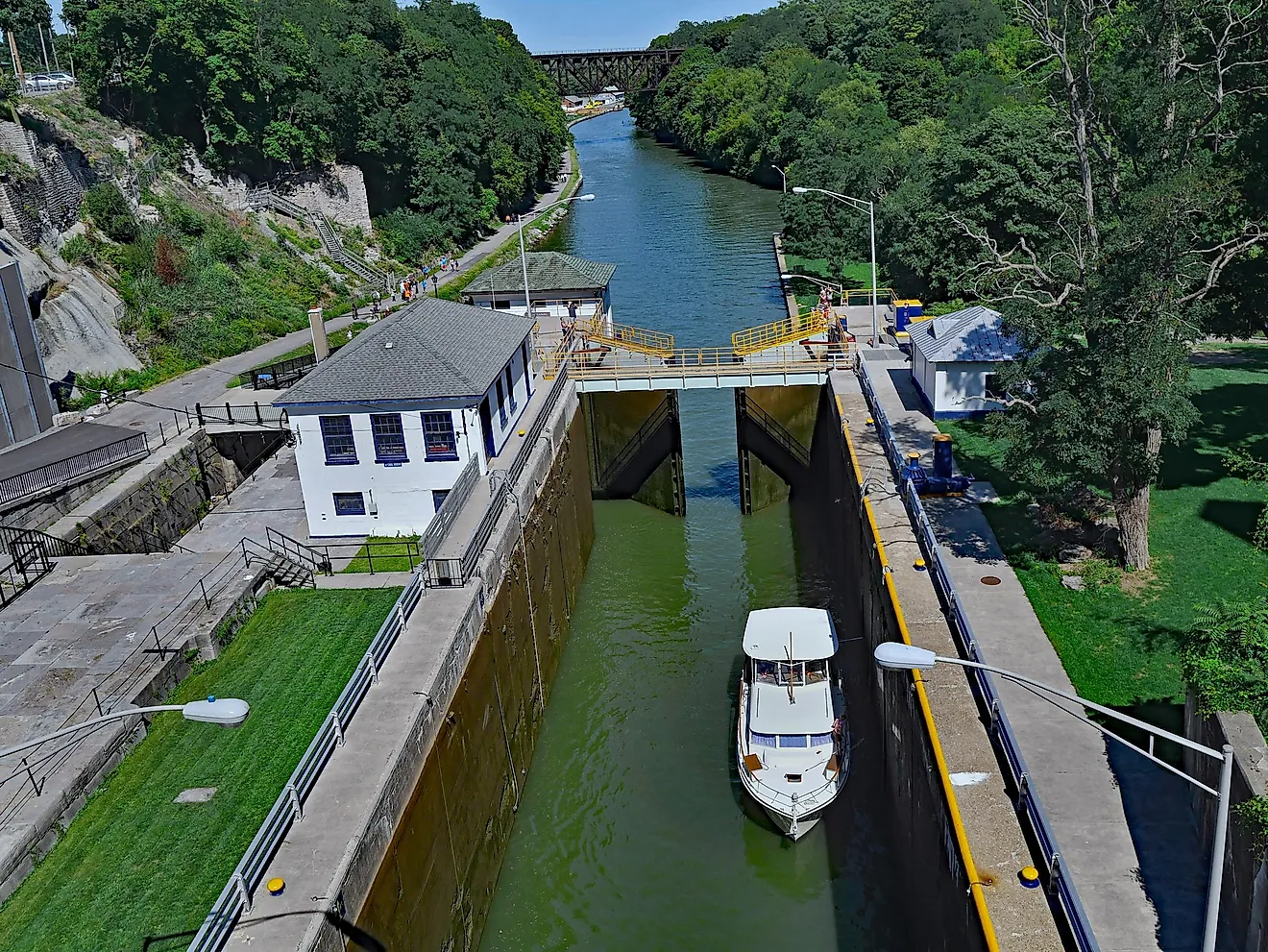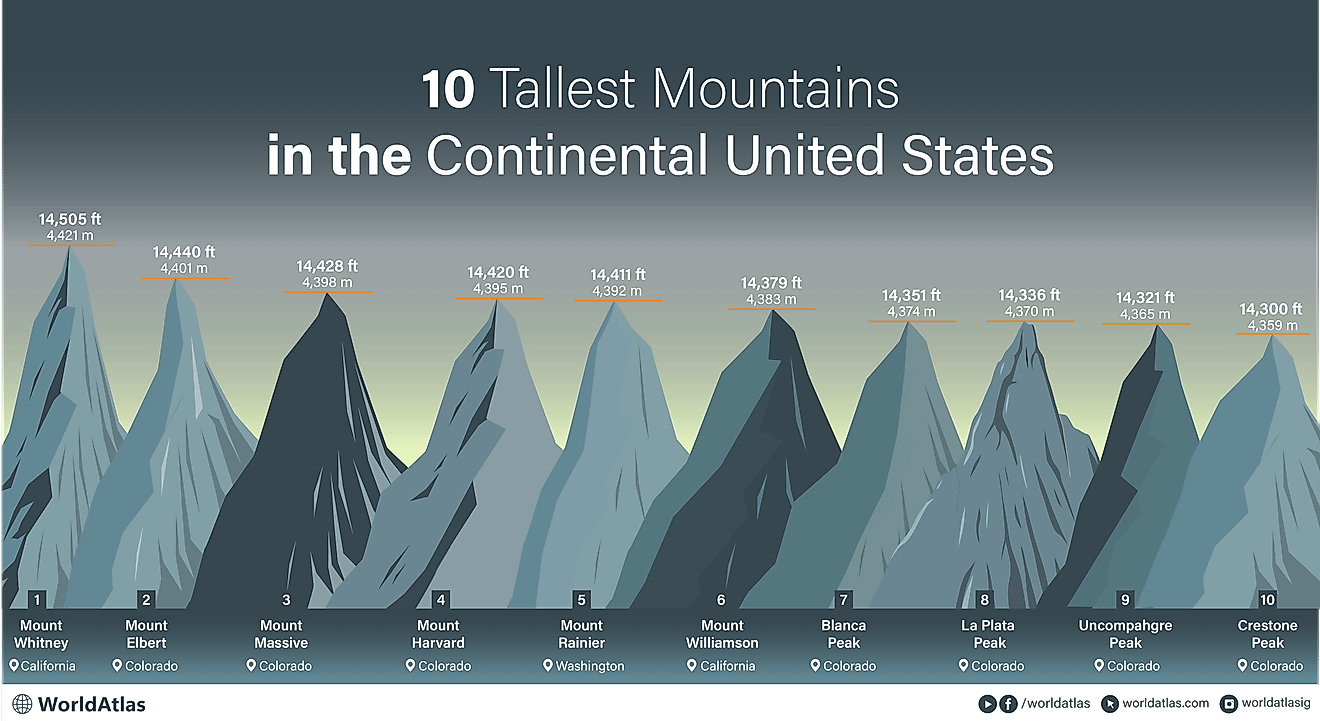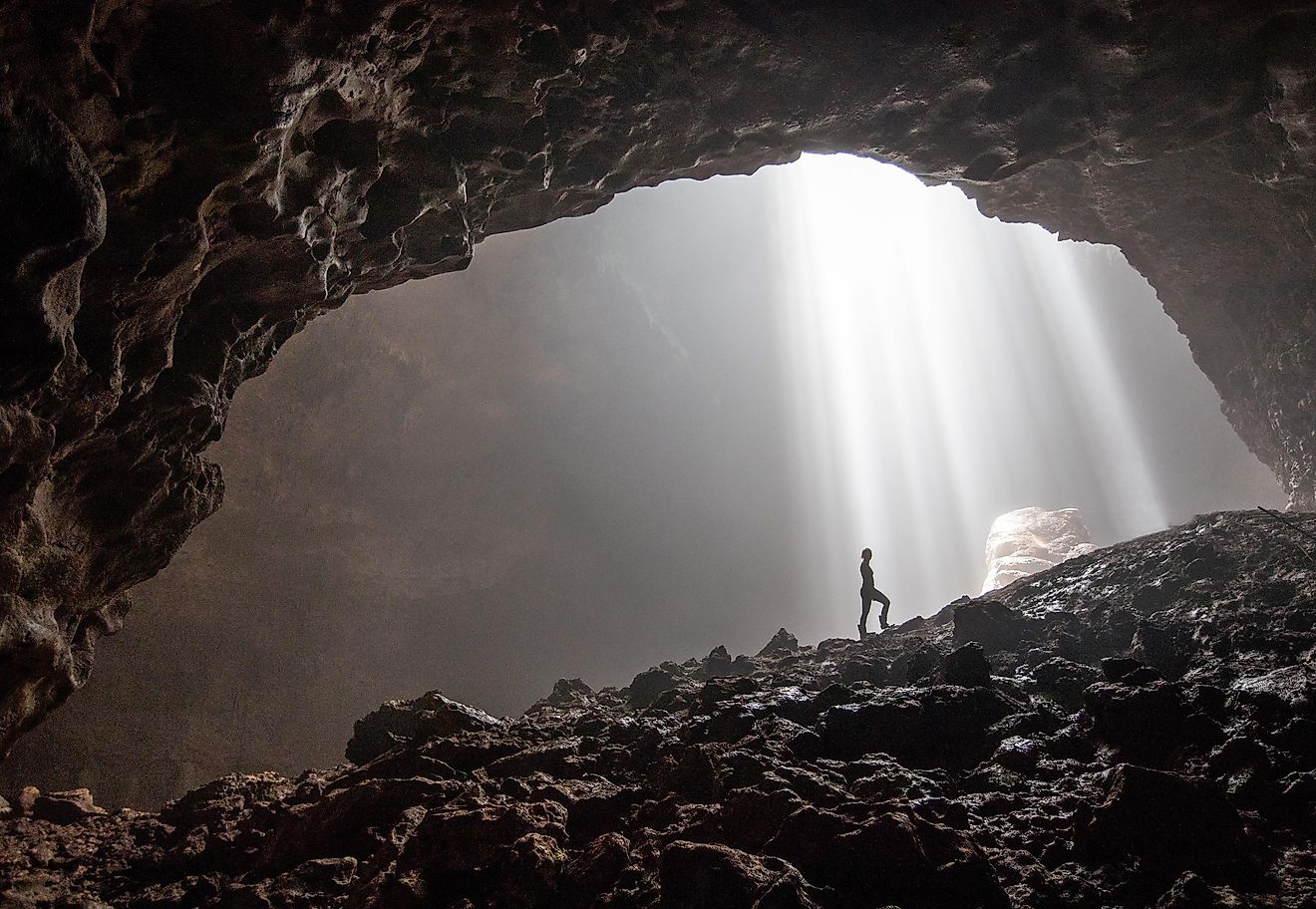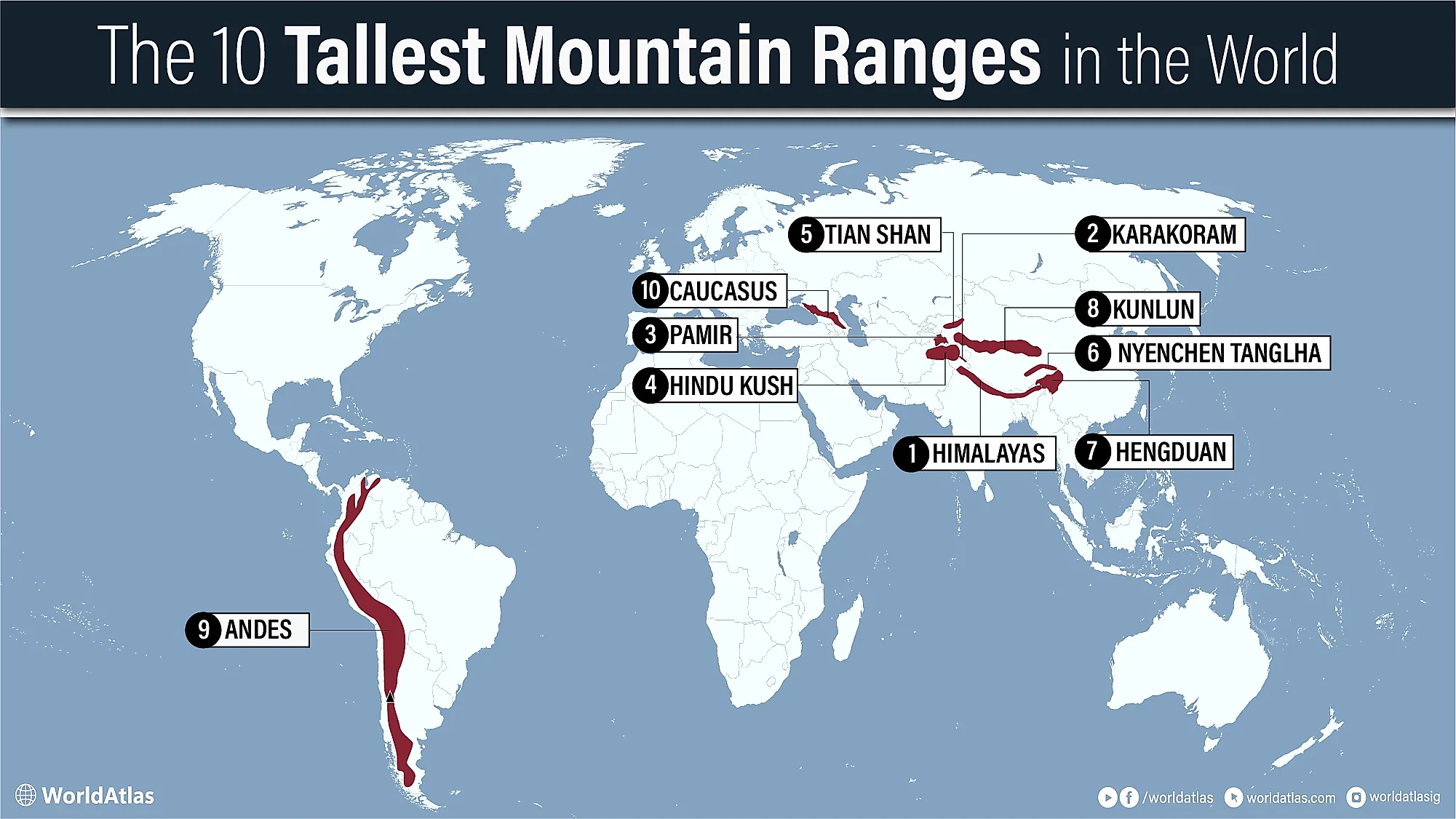
The World's Tallest Mountain Ranges
- The Himalayas is the tallest mountain range in the world, with Mount Everest marking its highest point.
- The eight tallest mountain ranges in the world can all be found in Asia.
- The Andes mountain range in South America is the longest range in the world.
What are the tallest mountain ranges on Earth, and how do we measure that?
Using the average height of each range's three highest peaks, the 10 tallest mountain ranges in the world are: Himalayas, Karakoram, Pamir, Hindu Kush, Tian Shan, Nyenchen Tanglha, Hengduan, Kunlun, Andes, and Caucasus.
Famous chains like the Rockies or the Alps don't appear because, peak for peak, they simply can't match Asia's brutal cluster of 7,000-8,000 m summits. Even the Andes, the world's longest range and the highest outside Asia, only rank ninth when you look at average summit height instead of a single record mountain.
The list also reveals a deeper pattern: eight of the ten tallest ranges are wrapped around the Tibetan Plateau, the vast uplift created by the collision of India and Eurasia. In other words, "the world's tallest mountain ranges" are really one gigantic, hyper-elevated system with a few outliers on its fringes.
10 Tallest Mountain Ranges In The World
| Rank | Range | Highest peak (m) | Avg. Height (Top 3 Peaks in m) |
|---|---|---|---|
| 1 | Himalayas | Everest - 8,849 | 8,650 |
| 2 | Karakoram | K2 - 8,611 | 8,247 |
| 3 | Pamir | Kongur Tagh - 7,649 | 7,575 |
| 4 | Hindu Kush | Tirich Mir - 7,708 | 7,534 |
| 5 | Tian Shan | Jengish Chokusu - 7,439 | 7,163 |
| 6 | Nyenchen Tanglha | Nyenchen Tanglha I - 7,162 | 7,108 |
| 7 | Hengduan | Minya Konka - 7,556 | 7,028 |
| 8 | Kunlun | Kunlun Goddess Peak - 7,167 | 7,025 |
| 9 | Andes | Aconcagua - 6961 | 6,883 |
| 10 | Caucasus | Elbrus - 5,642 | 5,333 |
1. Himalaya Range
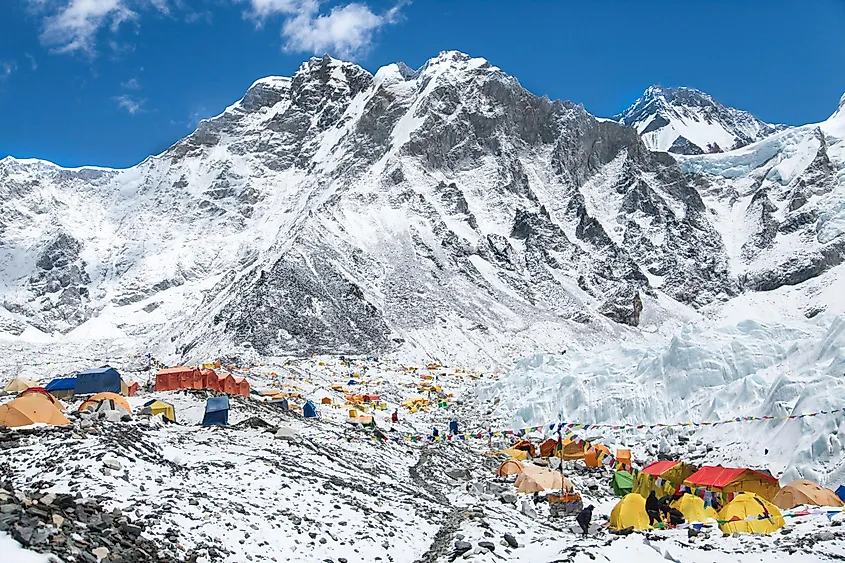
The Himalayas form the planet's highest mountain range, a 2,400-kilometre arc separating the Indian subcontinent from the Tibetan Plateau and crowned by Mount Everest (8,848.86 m). More than a hundred summits above 7,200 m, including Annapurna, Dhaulagiri, and Kangchenjunga, make this the ultimate high-altitude landscape.
The range is often defined as five countries, India, Nepal, Bhutan, China, and Pakistan, with occasional inclusion of Afghanistan, and its glaciers and snowfields feed Asia's great rivers: the Indus, Ganges and Brahmaputra, lifelines for hundreds of millions downstream. Born from the ongoing collision of the Indian and Eurasian tectonic plates, the Himalayas are still rising and are among the world's most seismically active regions.
Often called the "Third Pole", they contain around 15,000 glaciers but are warming rapidly, with accelerating ice loss and expanding glacial lakes. Ecologically, climates shift from lush subtropical foothills to alpine meadows and bare, wind-scoured summits, supporting rare wildlife such as snow leopards, red pandas, and Himalayan tahr. Culturally, the Himalayas anchor Hindu and Buddhist cosmology, with many peaks regarded as sacred and off-limits to climbers.
2. Karakoram Range
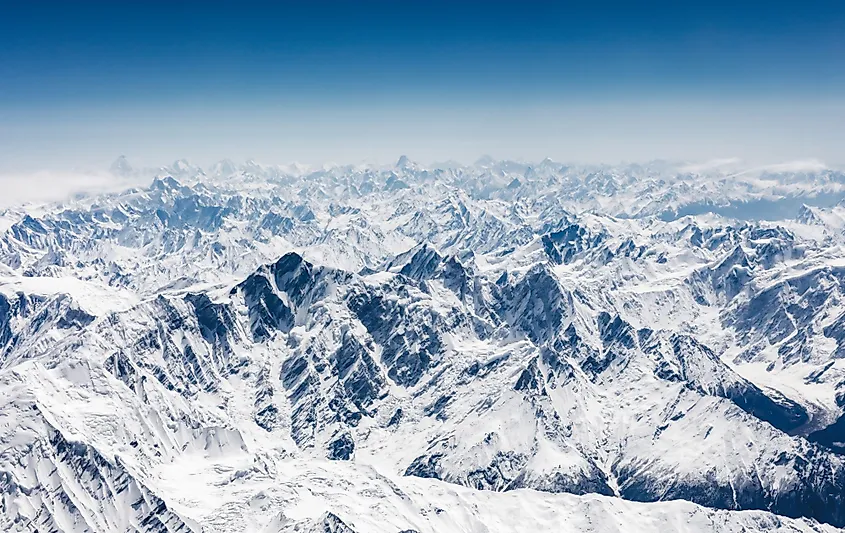
The Karakoram is the world's second-highest mountain range, dominated by K2 (8,611 m), and forms a rugged knot of peaks at the intersection of Pakistan, India, and China, with outliers reaching Afghanistan and Tajikistan. Roughly 500 km long, it rises north of the Indus and Shyok rivers and south of the Yarkand and Karakash, bridging the gap between the Himalayas, Pamir, Hindu Kush, and Kunlun ranges.
The Karakoram is also the most heavily glaciated region on Earth outside the poles: vast ice streams such as the Siachen, Baltoro, and Biafo glaciers power major rivers and carve some of the planet's most dramatic alpine scenery. The range boasts four eight-thousanders, K2, Gasherbrum I, Broad Peak, and Gasherbrum II, and more than a dozen summits above 7,500 m, concentrated in Pakistan-administered Gilgit-Baltistan and along the contested frontiers of Kashmir. Sitting on the active boundary between the Indo-Australian and Eurasian plates, it is geologically young, seismically restless, and shaped by ongoing uplift and heavy glacial erosion. Historically crossed by high passes such as the Karakoram and Khunjerab, this harsh landscape remains thinly populated yet culturally rich, linking Silk Road oases with high-altitude communities whose lives are closely tied to fragile ice and snow.
3. Pamir Range
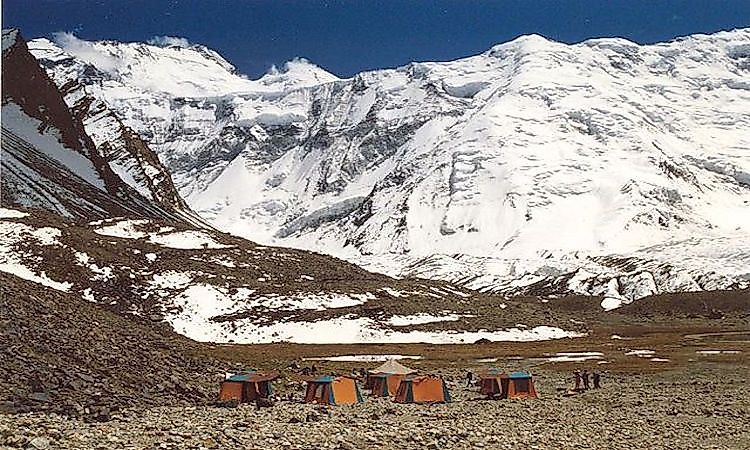
The Pamir Mountains form a high, compact knot of ranges between Central and South Asia, often called the "Roof of the World". At their eastern edge rises Kongur Tagh (7,649 m), the range's highest summit, with other major peaks such as Ismoil Somoni, Lenin, and Peak Ozodi exceeding 7,000 m. The Pamirs link some of Asia's great mountain systems, meeting the Tian Shan to the north, the Hindu Kush to the south, the Karakoram and Kunlun to the east, and the Himalayas to the southeast.
Shared by Tajikistan, Kyrgyzstan, Afghanistan, China, and Pakistan, the range is dominated by high plateaus, glaciated massifs and broad U-shaped "pamir" valleys used as summer pastures. Around ten percent of the area is ice-covered, with long valley glaciers feeding the headwaters of the Amu Darya and other rivers. The climate is severe: long, bitter winters, short cool summers and sparse precipitation support hardy grasslands but few trees.
Historically, Pamir passes carried branches of the Silk Road, and today the Pamir Highway remains a crucial, if precarious, lifeline across this remote region.
4. Hindu Kush Range

The Hindu Kush forms the high, western bastion of the greater Hindu Kush-Himalayan system and ranks among the world's loftiest mountain ranges. Stretching roughly 800 km across Afghanistan, Pakistan, and a corner of Tajikistan, it links with the Pamirs and Karakoram in the northeast and tapers southwest toward the highlands above Kabul. Its highest peak is Tirich Mir (7,708 m) in Pakistan's Chitral District, with many other summits rising well above 6,000 m in a harsh landscape of snowfields, glacier,s and deeply incised valleys.
The range is a major watershed divide, separating the Amu Darya basin to the north from the Indus system to the south. Glaciers and snowpack feed vital rivers such as the Kabul and Helmand, sustaining dry downstream regions. Historically, the Hindu Kush guarded and channelled movement between Central and South Asia: its passes carried Silk Road caravans, invading armies, and later imperial campaigns. Culturally, it was once a flourishing Buddhist heartland, home to sites such as the Bamiyan Buddhas, before Islam became dominant.
5. Tian Shan Range
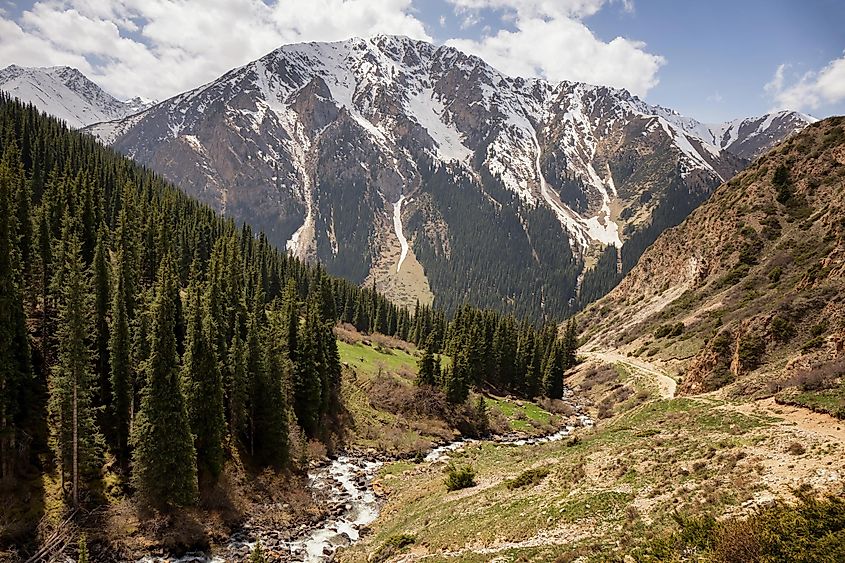
The Tian Shan, or "Mountains of Heaven," form one of the world's tallest mountain systems, arching for nearly 2,900 km across Kyrgyzstan, Kazakhstan, northwest China, Uzbekistan, and Tajikistan. Part of the broader Himalayan collision zone, the range rises to 7,439 m at Jengish Chokusu (Victory Peak), with Khan Tengri (7,010 m) the second-highest summit and a famed mountaineering objective. North and west of the Taklamakan Desert and Tarim Basin, the Tian Shan link Central Asia's steppe to the Pamirs and Altai, feeding major rivers such as the Syr Darya, Ili and Tarim from their glaciers and snowfields.
Despite their icy summits, Tian Shan valleys host rich walnut and wild apple forests, the cradle of the modern domesticated apple and other fruit crops that travelled along the Silk Road. Today, the range is a climate-change hotspot: its glaciers have lost more than a quarter of their ice since the 1960s and could halve again by 2050, threatening regional water supplies. Spiritually, the mountains are central to Tengrism; Khan Tengri is revered as "Lord of the Spirits." Recognized as a UNESCO World Heritage Site in both China and Central Asia, the Tian Shan combines extreme elevation, deep ecological value, and enduring cultural significance.
6. Nyenchen Tanglha Range
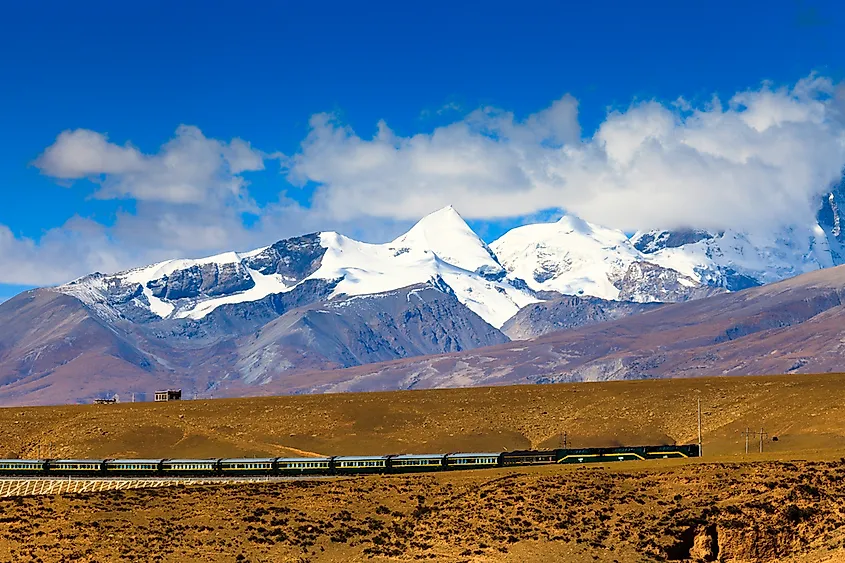
Forming the eastern backbone of the Transhimalaya, the Nyenchen Tanglha Mountains run for roughly 700 km across the Tibetan Plateau in China's Tibet Autonomous Region. Parallel to the main Himalaya and north of the Yarlung Tsangpo River, the range rises to 7,162 m at Mount Nyenchen Tanglha, its highest peak and the dominant summit north of Lhasa. Steep southern flanks drop more than 2,000 m toward the Yarlung Tsangpo, while the northern slopes ease onto the high, arid, vast Changtang plateau.
The range holds thousands of glaciers that blanket about 10,000 square kilometres, feeding rivers such as the Drukla Chu and sustaining downstream ecosystems and settlements. Nyenchen Tanglha is usually divided into West and East sectors at Tro La Pass. West Nyenchen Tanglha, looming above Lake Namtso, contains the range's four 7,000 m giants and separates Indian Ocean-fed monsoon valleys from the closed basins of northern Tibet.
East Nyenchen Tanglha, often dubbed the "Alps of Tibet," is a labyrinth of sharp, heavily glaciated peaks, with more than 240 summits over 6,000 m, including Sepu Kangri (6,956 m). Remote, storm-lashed, and rarely climbed, Nyenchen Tanglha anchors the high, glaciated heart of Asia in this ranking of the world's tallest mountain ranges.
7. Hengduan Range

The Hengduan Mountains form a knot of north-south ranges on the southeastern fringe of the Tibetan Plateau, linking high Tibet to the Yunnan-Guizhou Plateau and separating the lowlands of northern Myanmar from the Sichuan Basin. In this ranking of the world's tallest mountain ranges, Hengduan earns its place thanks to Mount Gongga (7,556 m), the highest peak east of the Himalayas, and major summits in the Daxue, Shaluli, Gaoligong and neighbouring ranges.
Carved by the Yangtze, Mekong and Salween, the UNESCO-listed "Three Parallel Rivers", the range is defined by extreme vertical relief, with deep gorges dropping from glaciated summits to subtropical valley floors. Largely unglaciated during the ice ages, Hengduan became a refuge and engine of evolution, today hosting one of Earth's richest temperate floras, subalpine conifer forests and iconic species such as the giant panda. It remains sparsely urbanised, with Lijiang the major city within the system.
8. Kunlun Range

Forming the vast northern rim of the Tibetan Plateau, the Kunlun Mountains are one of Asia's longest and loftiest ranges, earning their title in China as the "Forefather of Mountains." Stretching for more than 3,000 kilometres along the southern edge of the Tarim Basin and Taklamakan Desert, the Kunlun rise to 7,167 m at Liushi Shan, also known as Kunlun Goddess Peak, in the western section.
In this ranking of the world's tallest mountain ranges, the Kunlun stand out not just for height but for sheer scale: a massive wall separating the arid basins of Xinjiang from the high, windswept Changtang of northern Tibet. Several major rivers, including the jade-bearing Karakash and Yurungkash, descend from its glaciated flanks, while its Bayan Har subrange forms the watershed between the Yangtze and Yellow Rivers, China's two great lifelines.
Geologically, the Kunlun mark the northern edge of ancient continental collisions that helped build the Tibetan Plateau. They are remote and austere, crossed by only a couple of modern highways, and host the Kunlun volcanic group, a field of high cones last active in 1951. Layered onto this physical immensity is a deep mythic role: in classical Chinese cosmology, Kunlun is the axis of heaven and earth, home of gods, immortals, and the Queen Mother of the West.
9. Andes Range
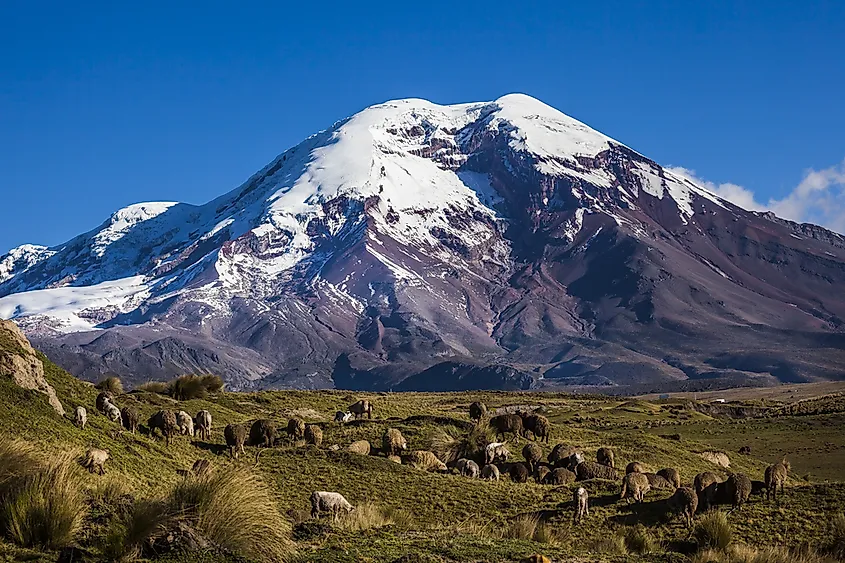
Running the entire spine of western South America, the Andes are the world's longest continental mountain range and the highest outside Asia. Stretching about 8,900 km through Venezuela, Colombia, Ecuador, Peru, Bolivia, Chile, and Argentina, they form a continuous wall of rock averaging 4,000 m in elevation and topping out at 6,961 m on Aconcagua in Argentina. Though individually lower than the Himalayan giants, the Andes' sustained height and vast extent firmly secure their place among the planet's tallest mountain ranges.
Structurally, the Andes are a classic subduction-built cordillera, raised where the Nazca and Antarctic plates dive beneath South America. They're divided into Tropical, Dry, and Wet Andes, and into Northern, Central, and Southern segments, each with distinct climates, ecosystems, and cultures. High plateaus such as the Altiplano rival Tibet in elevation, while the range also hosts the world's highest volcanoes, including Ojos del Salado on the Chile-Argentina border.
The Andes span everything from cloud forest to high desert and glacier, harbouring exceptional biodiversity and thousands of endemic plant and animal species. They were the heartland of the Inca Empire and remain densely populated today, home to major highland cities like Bogotá, Quito, La Paz, Cusco, and Santiago, and forming the mountainous backbone of the Americas.
10. Caucasus Range
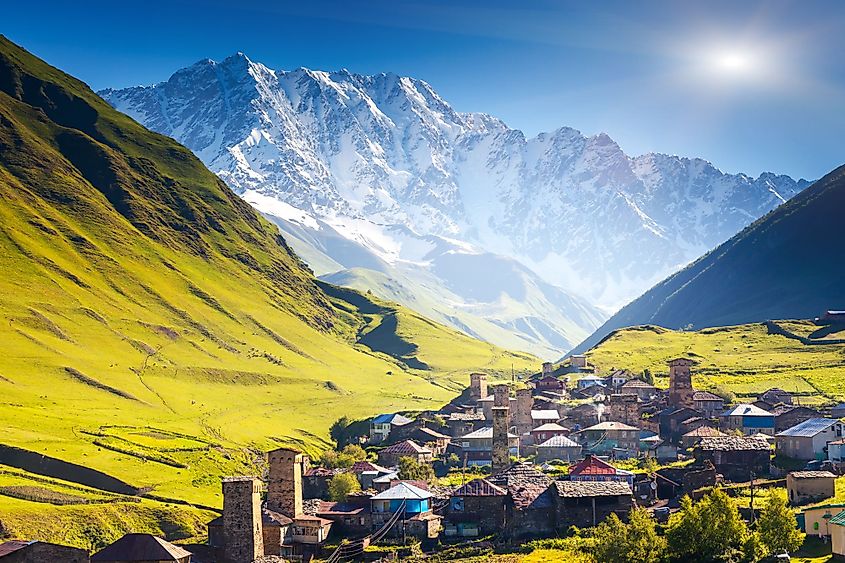
The Caucasus Mountains form one of the world's great high ranges, arching 1,200 km between the Black and Caspian Seas at the meeting point of Europe and Asia. Their highest peak, Mount Elbrus (5,642 m), is often classed as the tallest mountain in Europe, helping secure the Caucasus a place among the 10 tallest mountain ranges in the world. The system is divided into the higher, heavily glaciated Greater Caucasus to the north and the slightly lower Lesser Caucasus to the south, connected by the Likhi Range and bordered by lowlands such as the Colchis Plain and Kur-Araz basin.
Geologically, the Caucasus sits on the active Alpide belt, created by the collision of the Arabian and Eurasian plates. Jurassic-Cretaceous rocks, young volcanic plateaus and dormant volcanoes like Elbrus and Kazbek testify to its turbulent past, and the region remains seismically active, with devastating earthquakes recorded into modern times. Climate and landscapes vary sharply with height and exposure: extremely snowy western slopes with deep avalanches, drier basins to the east, dense beech and Colchian forests at mid-elevations, and alpine meadows and glaciers higher up. Historically, the range guarded a key branch of the Silk Road and still supports ancient transhumant shepherding routes.
Tallest Mountain Ranges In The World And Their Highest Peaks
| Rank | Range | Highest peak (m) | 2nd-highest peak (m) | 3rd-highest peak (m) | Avg. Height (Top 3 Peaks in m) |
|---|---|---|---|---|---|
| 1 | Himalayas | Everest - 8,849 | Kangchenjunga - 8,586 | Lhotse - 8,516 | 8,650 |
| 2 | Karakoram | K2 - 8,611 | Gasherbrum I - 8,080 | Broad Peak - 8,051 | 8,247 |
| 3 | Pamir | Kongur Tagh - 7,649 | Muztagh Ata - 7,546 | Kongur Jiubie - 7,530 | 7,575 |
| 4 | Hindu Kush | Tirich Mir - 7,708 | Noshaq - 7,492 | Istor-o-Nal - 7,403 | 7,534 |
| 5 | Tian Shan | Jengish Chokusu - 7,439 | Pshavella - 7,041 | Khan Tengri - 7,010 | 7,163 |
| 6 | Nyenchen Tanglha | Nyenchen Tanglha I - 7,162 | Nyenchen Tanglha II - 7,117 | Nyenchen Tanglha III - 7,046 | 7,108 |
| 7 | Hengduan | Minya Konka - 7,556 | Zhong Shan Feng - 6,904 | Tai Shan - 6,626 | 7,028 |
| 8 | Kunlun | Kunlun Goddess Peak - 7,167 | Ulugh Muztagh - 6,973 | Liushi Shan II - 6,936 | 7,025 |
| 9 | Andes | Aconcagua - 6961 | Ojos del Salado - 6,893 | Monte Pissis - 6,795 | 6,883 |
| 10 | Caucasus | Elbrus - 5,642 | Dykh-Tau - 5,205 | Shkhara - 5,152 | 5,333 |
